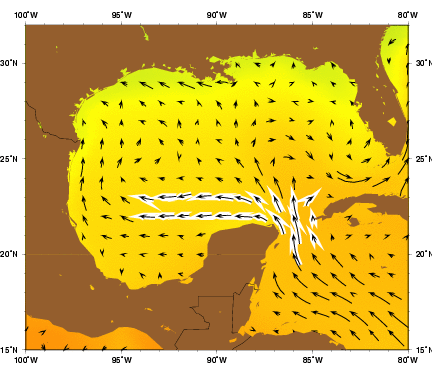
For those who have been living under a rock for the past few months, here is the summary of what's going on. On April 20th, 2010, there was an explosion on the Deepwater Horizon oil rig; which located in the Gulf of Mexico, just south-east of Louisana, USA. Several people lost their lives, while an underwater well starting leaking oil into the region. 5,000 - 25,000 barrels worth of oil per day flooded the ocean, with the obvious danger to ecosystems and wildlife. The coastlines of the USA's Louisana, Florida, Mississippi and Texas are all affected, as well as the waters around them.
This is still on-going, with the most pessimistic estimates stating that it will be Christmas before the clean-up is completed. In the intervening months, there have been several attempts to stem the tide of oil still leaking from the pipes. The oil rig's owners, BP, have tried various things, while an army of scientists, engineers and other experts have descended onto the issue. Solutions from the world's commentators have ranged from the feasible to the downright whacky. But most of the media debate has homed in on the more sensationalist stories of - who's to blame? While those in the spotlight seem to spend a lot of time explaining precisely why they aren't to blame.
That's the situation in a nutshell. For us down on the Mexican Caribbean, we can be very thankful for a wonderful natural current that pulls the oil away from us; while being concerned about the future for our marine wildlife.
Try to picture the current of the world's oceans as a gigantic conveyor belt. The prevailing current alongside us has come from West Africa. It surges across the Atlantic Ocean, through the Caribbean Sea and up the Yucatán Straits. Think back to all of those early pirate blogs that I wrote, about how Spanish galleons, reliant on windpower and currents, had to sail north out of the Caribbean Sea, in order to cross into Europe. They were using this very same current.


The Yucatán current
It is this current that has not allowed the oil leak to head south onto the beaches of Cancún and the Riviera Maya.
What is anticipated is that the bulk of the oil, currently trapped in an eddy called Franklin, will be released onto the coastline of Texas, USA. It will then be carried back east and will eventually be taken out into the North Atlantic. There it will continue to do untold damage to the ecosystems of the East Coast of America.
It is possible that, as the eddies break down, oil could just touch the tip of the Yucatán Straits. If this happens at all, it will be in the late autumn, possibly around October or November. This is being monitored, with a series of 80 buoys set up outside of Alacranes Reef a month ago. The buoys are fitted with sampling devices and satellite transmitters, at different depths, which act as an early warning system for those receiving the data. In any case, it is unlikely that oil in the Yucatán would be in liquid form, nor nearly as toxic as it's been in Louisana. It is also likely that it would be well below the surface and far from the beaches, as a south-eastern current will then pick it up and take it into the Florida Straits. While not good, it's certainly not as bad as it could have been.
Yesterday, the internet suddenly erupted with news, from Miami, USA, that the oil leak has travelled down to Cancún. This was news indeed for us, who are eye-witnesses to miles of still unblemished beaches. We are also in daily contact with those on the 'front line', ie the fishermen, boat operators, divers and others who make a living out in the waters of the Mexican Caribbean. None of them have reported seeing any oil or disperants at all. We have been gazing long and hard at the satellite images that purportedly show the oil this far south. While it does, indeed, show a black mark, it doesn't actually say that it's oil. For the moment, we'll believe the evidence of our own eyes and simply report that our beaches are completely free of oil. We'll be the first to tell you when they aren't.

As for the current real effect on the Mexican Caribbean, the concern is for migrating marine life. The larvae of fish and lobsters all travel north. They would have been saved by the eddies and should have made it through; however, the homeward journey could well be another matter.
Also, little is known about the migratory path of the whale sharks. They exist in the Yucatán Straits, but have also been seen near Louisana. Are they the same whales sharks? Or two different colonies? Marine biologists are currently fitting them with tracking devices to find out. If they are the same, then this endangered species is in big trouble; along with the equally endangered bluefin tuna, which spawns in the region of the oil leak. Several agencies are out looking for the whale sharks. Some have been seen already. We are just anxiously awaiting the safe return of the rest.
While the situation further north is terrible, we can confidently state that the oil leak isn't in the Mexican Caribbean. If you have booked, or thinking of booking, your vacation here, then please stop worrying about the oil ruining your break. The Caribbean is still pristine; the sands are still white. We're extremely confident that they'll stay that way.


No comments:
Post a Comment